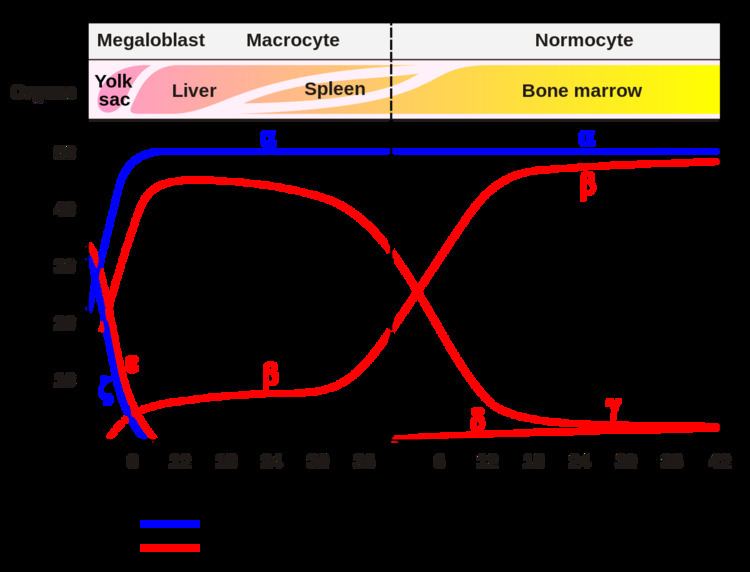 | ||
At the end of pregnancy, the fetus must take the journey of childbirth to leave the reproductive female mother. Upon its entry to the air-breathing world, the newborn must begin to adjust to life outside the uterus.
Contents
Breathing and circulation
Perfusing its body by breathing independently instead of utilizing placental oxygen delivered via the umbilical cord is the first challenge of a newborn. At birth, the baby's lungs are filled with lung liquid, which is distinct from amniotic fluid. When the newborn is expelled from the birth canal, its central nervous system reacts to the sudden change in temperature and environment. This triggers it to take the first breath, within about 10 seconds after delivery. With the first breaths, there is a fall in pulmonary vascular resistance, and an increase in the surface area available for gas exchange. Over the next 30 seconds the pulmonary blood flow increases and is oxygenated as it flows through the alveoli of the lungs. Oxygenated blood now reaches the left atrium and ventricle, and through the descending aorta reaches the umbilical arteries. Oxygenated blood now stimulates constriction of the umbilical arteries resulting in a reduction in placental blood flow. As the pulmonary circulation increases there is an equivalent reduction in the placental blood flow which normally ceases completely after about three minutes. These two changes result in a rapid redirection of blood flow into the pulmonary vascular bed, from approximately 4% to 100% of cardiac output. The increase in pulmonary venous return results in left atrial pressure being slightly higher than right atrial pressure, which closes the foramen ovale. The flow pattern changes results in a drop in blood flow across the ductus arteriosus and the higher blood oxygen content of blood within the aorta stimulates the constriction and ultimately the closure of this fetal circulatory shunt.
All of these cardiovascular system changes result in the adaptation from fetal circulation patterns to an adult circulation pattern. During this transition, some types of congenital heart disease that were not symptomatic in utero during fetal circulation will present with cyanosis or respiratory signs.
It is common obstetric practice to intervene in these changes by applying a clamp to the umbilical cord, often within 20 seconds of birth, before transition has taken place. However delayed clamping (>1min) may have benefits in terms of iron status.
Following birth, the expression and re-uptake of surfactant, which begins to be produced by the fetus at 20 weeks gestation, is accelerated. Expression of surfactant into the alveoli is necessary to prevent alveolar closure (atelectasis). At this point, rhythmic breathing movements also commence. If there are any problems with breathing, management can include stimulation, bag and mask ventilation, intubation and ventilation. Cardiorespiratory monitoring is essential to keeping track of potential problems. Pharmacological therapy such as caffeine can also be given to treat apnea in premature newborns. A positive airway pressure should be maintained, and neonatal sepsis must be ruled out.
Potential neonatal respiratory problems include apnea, transient tachypnea of the newborn (TTNB), respiratory distress syndrome (RDS), meconium aspiration syndrome (MAS), airway obstruction, and pneumonia.
Energy metabolism
Energy metabolism in the fetus must be converted from a continuous placental supply of glucose to intermittent feeding. While the fetus is dependent on maternal glucose as the main source of energy, it can use lactate, free-fatty acids, and ketone bodies under some conditions. Plasma glucose is maintained by glycogenolysis.
Glycogen synthesis in the liver and muscle begins in the late second trimester of pregnancy, and storage is completed in the third trimester. Glycogen stores are maximal at term, but even then, the fetus only has enough glycogen available to meet energy needs for 8–10 hours, which can be depleted even more quickly if demand is high. Newborns will then rely on gluconeogenesis for energy, which requires integration, and is normal at 2–4 days of life.
Fat stores are the largest storage source of energy. At 27 weeks gestation, only 1% of a fetus' body weight is fat. At 40 weeks, that number increases to 16%. Inadequate available glucose substrate can lead to hypoglycemia, fetal growth restriction, preterm delivery, or other problems. Similarly, excess substrate can lead to problems, such as infant of a diabetic mother (IDM), hypothermia or neonatal sepsis.
Anticipating potential problems is the key to managing most neonatal problems of energy metabolism. For example, early feeding in the delivery room or as soon as possible may prevent hypoglycemia. If the blood glucose is still low, then an intravenous (IV) bolus of glucose may be delivered, with continuous infusion if necessary. Rarely, steroids or glucagon may have to be employed.
Temperature regulation
Newborns come from a warm environment to the cold and fluctuating temperatures of this world. They are naked, wet, and have a large surface area to mass ratio, with variable amounts of insulation, limited metabolic reserves, and a decreased ability to shiver. Physiologic mechanisms for preserving core temperature include vasoconstriction (decrease blood flow to the skin), maintaining the fetal position (decrease the surface area exposed to the environment), jittery large muscle activity (generate muscular heat), and "non-shivering thermogenesis". The latter occurs in "brown fat" which is specialized adipose tissue with a high concentration of mitochondria designed to rapidly oxidize fatty acids in order to generate metabolic heat. The newborn capacity to maintain these mechanisms is limited, especially in premature infants. As such, it is not surprising that some newborns may have problems regulating their temperature. As early as the 1880s, infant incubators were used to help newborns maintain warmth, with humidified incubators being used as early as the 1930s.
Basic techniques for keeping newborns warm include keeping them dry, wrapping them in blankets, giving them hats and clothing, or increasing the ambient temperature. More advanced techniques include incubators (at 36.5 °C), humidity, heat shields, thermal blankets, double-walled incubators, and radiant warmers while the use of skin-to-skin "kangaroo care" interventions for low birth-weight infants have started to spread world-wide after its use as a solution in developing countries.
